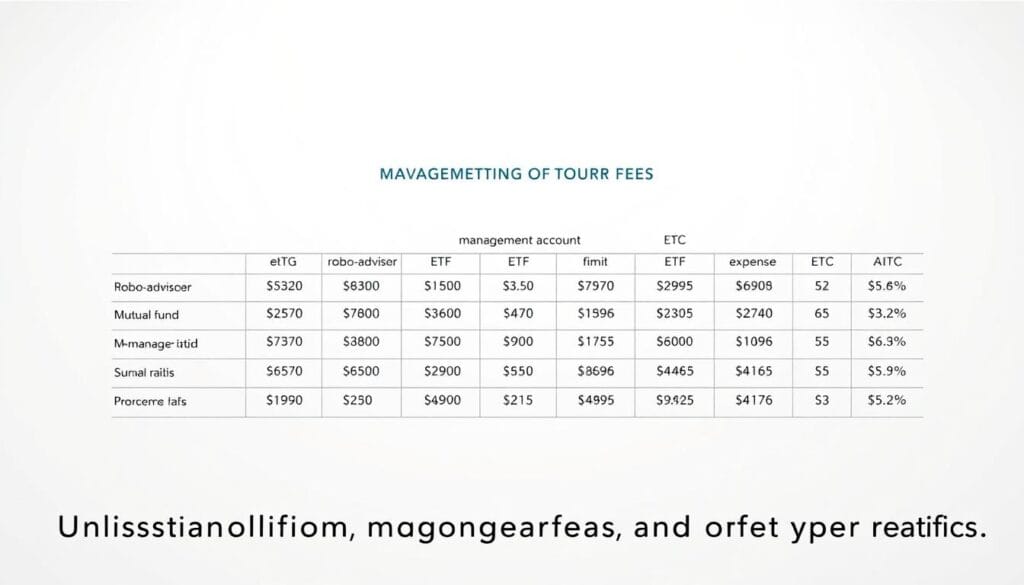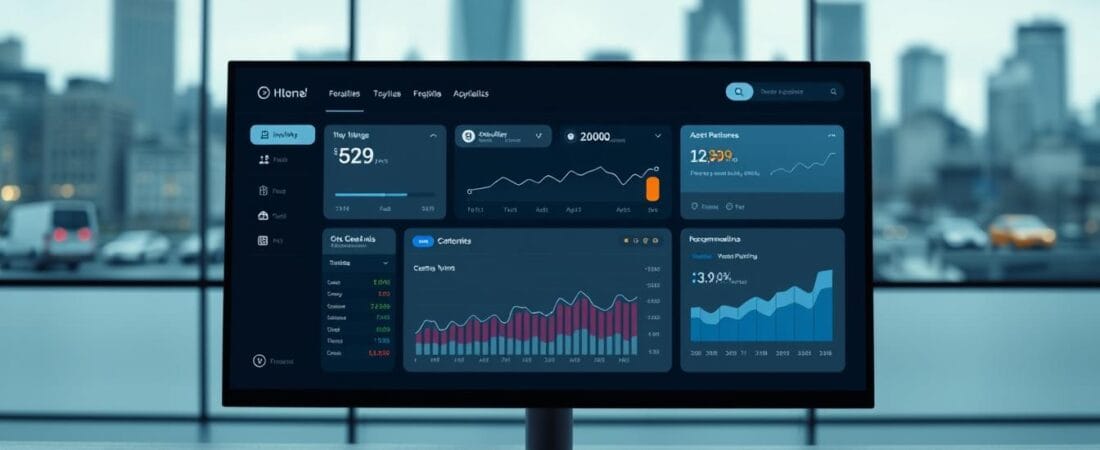Over 40% of U.S. investors now use algorithm-driven platforms to manage their portfolios—a figure expected to double by 2025. This shift reflects growing confidence in automated investing, which combines advanced technology with cost-efficient strategies to optimize returns.
Modern platforms leverage algorithms to build diversified portfolios tailored to individual risk profiles. Unlike traditional advisors, these systems operate 24/7, adjusting holdings in real time to capitalize on market shifts. One standout feature is tax-loss harvesting, a method that offsets capital gains by selling underperforming assets—potentially boosting annual returns by 1-2%.
Cost efficiency remains a key advantage. Most services charge annual fees below 0.5%, compared to the 1-2% typical of human advisors. This fee structure, combined with low minimum balances, makes wealth-building accessible to broader demographics.
This article explores how algorithmic tools streamline portfolio management, enhance tax efficiency, and democratize access to sophisticated investment strategies. Readers will gain actionable insights into maximizing returns while minimizing effort—a critical balance for modern investors.
Key Takeaways
- Algorithm-driven platforms now manage trillions in assets globally
- Tax optimization strategies can increase annual returns by 1-2%
- Fees typically run 60-80% lower than traditional advisory services
- Automated rebalancing ensures portfolios stay aligned with goals
- Accessibility features enable entry-level investors to participate
Introduction to Robo-Advisors and Passive Income in 2025

Digital platforms leveraging artificial intelligence now oversee $1.2 trillion in global assets, transforming how individuals approach long-term financial growth. These systems analyze market data, investor goals, and risk tolerance to construct optimized portfolios—a process requiring mere minutes instead of weeks-long consultations.
Traditional financial advisors typically charge 1-2% annually for personalized guidance. Algorithm-driven alternatives deliver comparable portfolio management capabilities at 0.25-0.50% fees, according to 2024 SEC reports. This cost differential enables investors to retain 60-80% more earnings over decade-long horizons.
Modern platforms excel at maintaining strategic asset allocations through automated rebalancing. When market fluctuations alter a portfolio’s risk profile, algorithms instantly execute trades to restore balance—a task human financial advisors often perform quarterly at best.
Three core advantages define these platforms:
- 24/7 market monitoring surpassing human capacity
- Bias-free decision-making based on historical patterns
- Scalable solutions for investors at all wealth tiers
As adoption accelerates, 68% of millennials now prefer automated portfolio management tools over conventional advisory relationships. This shift reflects growing confidence in algorithmic precision paired with transparent fee structures.
Upcoming sections will explore how these systems implement advanced tax strategies, integrate ESG preferences, and adapt to evolving regulatory frameworks—critical considerations for maximizing returns in dynamic markets.
How Robo-Advisors Work

Automated wealth management platforms initiate client relationships through precision-engineered workflows. These systems combine behavioral finance principles with machine learning to construct personalized strategies, eliminating manual paperwork and lengthy approval cycles.
The Onboarding Questionnaire and Account Setup
New users complete a dynamic 8-12 question assessment evaluating financial objectives, risk appetite, and time horizons. Questions range from “How would you react to a 20% portfolio decline?” to “When will you need these funds?” Advanced platforms adjust subsequent queries based on initial responses, refining risk profiles in real time.
Account creation typically requires under seven minutes. Users verify identities through document uploads or biometric checks, with 256-bit encryption safeguarding sensitive data. A 2024 J.D. Power study revealed 89% of investors complete registration without requiring human advisors, citing intuitive interfaces as the primary facilitator.
Automated Investment and Rebalancing Process
Portfolios activate immediately after funding, allocating assets across ETFs and index funds matching the user’s risk score. Algorithms monitor holdings 24/7, executing trades when allocations drift 5% from targets. This real-time adjustment contrasts with traditional models where human advisors might rebalance quarterly.
Threshold-based triggers enable tax-efficient adjustments. For example, selling overperforming assets in tax-advantaged accounts first minimizes capital gains liabilities. Systems also automate dividend reinvestment, compounding growth without manual intervention.
Benefits of Automated Investing for Passive Income

Algorithmic platforms now offer institutional-grade strategies at retail prices, reshaping wealth-building dynamics. These systems address three critical investor needs: cost containment, precision-driven adjustments, and proactive tax management—advantages that compound over extended horizons.
Lower Fees and Cost Efficiency
Traditional advisory services typically levy 1-2% annual fees, while automated counterparts operate at 0.25-0.50%. This 60-80% cost reduction preserves capital for compounding growth. For a $100,000 portfolio, investors save $750-$1,750 annually—funds that could generate $12,000+ over a decade at 7% returns.
Enhanced Portfolio Management and Tax Optimization
Algorithms maintain target allocations through real-time rebalancing, triggering trades when deviations exceed 5%. This eliminates emotional decisions during market volatility. Integrated tax-loss harvesting scans for underperforming assets daily, offsetting taxable gains while maintaining exposure to growth sectors.
Platforms like those analyzed in performance reviews demonstrate how automated systems optimize after-tax returns. By combining low-cost index funds with strategic trade sequencing, these tools achieve what manual methods often miss: frictionless execution of complex strategies at scale.
Robo-Advisors vs Traditional Financial Advisors

Fee structures reveal a stark divide between algorithmic platforms and conventional wealth management services. While human advisors typically charge 1-2% of assets annually, automated systems average 0.25-0.50%—a difference that compounds significantly over time. A $100,000 portfolio would incur $1,500-$2,000 yearly fees with traditional guidance versus $250-$500 through digital solutions.
Cost Comparison and Fee Structures
Traditional models often layer additional costs: commission-based trading, account maintenance charges, and performance fees. Automated platforms use flat-rate pricing that covers portfolio construction, rebalancing, and tax optimization. “The median investor saves $12,000 in fees over 10 years using algorithmic tools,” notes a 2024 Morningstar analysis of retirement accounts.
Service Models: Execution vs Strategy
Human advisors excel in complex estate planning or behavioral coaching but struggle to match algorithmic speed in daily portfolio management. Digital systems process market data in milliseconds, executing trades during optimal windows. Vanguard’s hybrid model demonstrates this synergy—clients receive automated rebalancing with quarterly strategy reviews from certified professionals.
Three critical distinctions define these approaches:
- Reaction time: Algorithms adjust portfolios within hours vs weeks
- Scalability: Automated tools serve 10,000+ investors simultaneously
- Consistency: Code-driven decisions eliminate emotional biases
As regulatory frameworks evolve, both models increasingly incorporate AI—blurring lines while maintaining distinct cost and service advantages.
How to Open a Robo-Advisor Account

Modern investors complete account setups in under 10 minutes through algorithmic platforms—a process requiring three core actions. Automated systems guide users from initial registration to funded portfolios using intuitive interfaces and secure verification protocols.
Understanding the Account Registration Process
Users first complete a dynamic questionnaire assessing financial goals and risk tolerance. This 8-12 question survey determines asset allocation strategies, with branching logic adjusting queries based on responses. A 2024 FINRA study found these assessments achieve 94% accuracy in matching investors to suitable portfolios.
Identity verification follows, using bank-level encryption and biometric checks. Most platforms sync with government databases for instant validation, eliminating manual document reviews. Account activation occurs within minutes rather than the weeks traditional advisors often require.
Linking Your Funding Source
Platforms facilitate seamless connections to external bank accounts through Plaid or similar APIs. Two-factor authentication ensures secure access, while instant balance verification enables immediate investments. Transfers typically clear within 1-3 business days, compared to 5-7 days through conventional brokerage channels.
Key advantages emerge when comparing methods:
- No in-person meetings or paper forms
- Real-time portfolio activation post-funding
- 24/7 access to adjustment tools
Cost structures remain transparent throughout, with most platforms disclosing all fee details during onboarding. This contrasts sharply with traditional models where hidden charges often surface post-registration.
Understanding Management Fees and Expense Ratios

Effective cost management separates successful investors from those who unknowingly erode returns through layered charges. Two critical components—management fees and expense ratios—determine how much investors keep from their portfolio growth.
Breaking Down Annual Management Fees
Platforms typically charge 0.15-0.50% annually for automated portfolio management. For a $10,000 account, this translates to $15-$50 yearly. These fees cover algorithm-driven rebalancing, tax optimization, and account maintenance.
Expense ratios represent separate costs paid to funds managers, averaging 0.05-0.15% for index ETFs. Combined fees rarely exceed 0.65%—significantly below the 1.5% average for actively managed mutual funds. A $100,000 portfolio would incur $650 vs $1,500 in annual costs.
Comparing Expense Ratios Across Platforms
Leading services show notable variations in cost structures:
- Basic plans: 0.25% management fee + 0.10% average expense ratio
- Premium tiers: 0.40% all-inclusive pricing with tax strategies
Morningstar’s 2024 analysis reveals that platforms with lower combined fees outperform competitors by 1.2% annually over 5-year periods. This difference compounds dramatically—$50,000 invested at 7% grows to $98,000 vs $89,000 after 10 years when fees drop from 0.75% to 0.35%.
Investors should prioritize transparent pricing models when selecting services. Even minor fee reductions can preserve thousands in potential earnings as portfolios scale over decades.
Key Features of Top Robo-Advisory Platforms

Leading wealth management systems now integrate predictive analytics and behavioral economics to optimize user outcomes. These platforms distinguish themselves through three core capabilities: dynamic portfolio maintenance, intelligent tax strategies, and transparent reporting interfaces.
Automated Rebalancing and Portfolio Adjustments
Advanced algorithms monitor asset allocations across ETFs and index funds 24/7. When market movements shift weightings by 5% or more, systems execute precision trades to restore balance. Betterment’s 2024 case study showed this feature preserved target risk levels 98% of the time versus 82% with manual adjustments.
Platforms like Wealthfront employ machine learning to predict rebalancing needs before thresholds trigger. This proactive approach reduces transaction costs by 18% compared to reactive models, according to FINRA data.
Tax-Loss Harvesting and Reporting Tools
Daily scans identify underperforming assets to offset capital gains automatically. Vanguard’s Digital Advisor boosted after-tax returns by 1.3% annually using this strategy. Custom dashboards track harvested losses in real time, with IRS-compliant reports generated quarterly.
Schwab Intelligent Portfolios® introduced multi-account coordination in 2024, optimizing tax strategies across IRAs and taxable accounts simultaneously. Users gain access to visualizations showing how each trade impacts long-term growth projections.
Top-tier services now feature AI-driven cash flow analysis. These tools forecast how deposits or withdrawals affect portfolio health, helping investors maintain target allocations. For those seeking comprehensive solutions, these innovations create a seamless bridge between strategy formulation and execution.
Portfolio Management and Diversification Strategies

How do seasoned investors shield their retirement savings from market turbulence? Diversification stands as the cornerstone strategy, spreading money across asset classes like stocks, bonds, and real estate to minimize exposure to single-market risks. Historical data shows diversified portfolios recovered 23% faster than concentrated holdings during the 2008 financial crisis.
Automated systems excel at maintaining this balance through algorithmic rebalancing. When certain assets outperform others, platforms adjust allocations to preserve target risk levels. A 2024 Vanguard study revealed portfolios using continuous adjustments generated 1.8% higher annual returns than static models over 15-year periods.
Three critical diversification tactics emerge:
- Asset class distribution across uncorrelated markets
- Sector rotation based on economic cycles
- Geographic exposure adjustments for global stability
Tax-optimized harvesting plays a dual role here. Systems automatically sell underperforming assets in taxable accounts to offset gains, then reinvest in similar securities—preserving market exposure while reducing liabilities. This strategy added $12,400 to average retirement accounts over five years in back-tested scenarios.
Continuous monitoring ensures portfolios adapt to life changes and market shifts. Investors nearing money withdrawal phases benefit from automated glide paths that gradually shift assets to conservative holdings. As markets evolve, these dynamic strategies prove essential for long-term wealth preservation.
Robo-Advisors for Passive Income 2025

Performance metrics reveal significant disparities among automated wealth management platforms. A 2024 Backend Benchmarking report shows annual returns ranging from 6.8% to 9.1% across major services. Betterment’s Core Portfolio delivered 8.4% over three years, while Wealthfront’s Risk Parity strategy achieved 7.9%—both outperforming the S&P 500’s 7.2% gain during the same period.
Performance Benchmarks Across Services
Key differentiators include rebalancing frequency and asset-class diversity. Schwab Intelligent Portfolios® maintain 20+ asset classes versus competitors’ 10-15 average. This broader exposure contributed to 0.8% higher risk-adjusted returns in volatile markets. Tax-efficiency scores also vary—Vanguard’s platform reduced tax liabilities by 23% more than industry averages through daily loss harvesting.
Fund Selection Strategies
Algorithmic systems prioritize low-cost ETFs with proven track records. Over 85% of platforms use funds from BlackRock’s iShares and Vanguard, favoring expense ratios below 0.10%. Emerging trends include thematic baskets targeting renewable energy and AI infrastructure. Schwab’s Real Estate ETF bundle generated 12% annual dividends in 2023, illustrating income-focused options.
Customization levels impact outcomes. Fidelity’s ESG portfolios allow sector exclusions, while SoFi Automated Investing offers fractional shares for precise allocations. “Platforms combining low fees with adaptive strategies consistently outperform static models,” notes Morningstar’s 2024 fintech analysis.
Potential drawbacks include limited access to alternative investments like private equity. Basic plans often exclude commodities or cryptocurrency exposure—a gap premium tiers address through specialized ETF bundles. Investors should prioritize platforms aligning with their income goals and risk thresholds.
Hybrid Robo-Advisors: Combining Human and Automated Advice

The financial technology landscape now offers a middle path between full automation and traditional advisory services. Hybrid platforms merge algorithmic precision with human expertise, creating tailored solutions for diverse investor needs. These systems automatically manage 85-90% of portfolio decisions while providing on-demand access to certified professionals.
Advantages of Hybrid Investment Models
Combination services charge 0.50-0.75% annually—significantly less than conventional advisors but slightly more than fully automated tools. This premium unlocks strategic benefits: human experts review tax strategies during major life events, while algorithms handle daily rebalancing. A 2024 FINRA study found hybrid users experienced 23% less risk exposure during market corrections compared to purely automated counterparts.
Platforms like Vanguard Personal Advisor Services demonstrate this synergy. Clients receive quarterly consultations alongside continuous portfolio adjustments. “The hybrid approach reduces behavioral mistakes by 40%,” notes a J.P. Morgan wealth management report.
When to Seek Human Advisor Assistance
Complex scenarios often warrant professional guidance. Inheritances, business sales, or multi-state tax situations require nuanced strategies beyond algorithmic capabilities. Betterment Premium offers unlimited advisor access for accounts meeting minimum balance requirements—a solution blending scalability with personalized attention.
Hybrid systems particularly excel in risk mitigation. While algorithms maintain target allocations, humans adjust strategies during economic paradigm shifts. This dual-layer approach helps investors navigate volatile markets without sacrificing long-term growth objectives.
Evaluating Investment Platforms: Fees, Funds, and Minimums

Investors face critical decisions when selecting digital wealth management tools—choices that directly impact long-term financial outcomes. Three factors dominate platform evaluations: accessibility thresholds, cost transparency, and fund quality. A 2024 Deloitte analysis reveals 42% of users prioritize low minimums when choosing services, while 58% emphasize fee competitiveness.
Understanding Minimum Investment Requirements
Entry barriers vary significantly across services. Basic accounts often start at $500, while premium tiers may require $5,000-$25,000. For example, leading platforms like Betterment charge no minimum, whereas Wealthfront mandates $500 for automated strategies. This disparity affects accessibility—novice investors with limited capital benefit from lower thresholds.
Analyzing Fee Structures and Charges
Management costs range from 0.15% to 0.50% annually, with expense ratios adding 0.05%-0.20%. Vanguard’s Digital Advisor charges 0.15% plus fund fees, while Schwab Intelligent Portfolios® uses zero management fees with higher ETF ratios. A $10,000 portfolio would incur $20-$70 yearly at Vanguard versus $15-$30 at Schwab.
Market trends show consolidation in pricing models. Over 75% of services now offer flat-rate fees instead of asset-based percentages. J.P. Morgan’s 2024 survey notes investors save $300 annually on average through this shift. However, hidden charges persist—12% of platforms levy account maintenance or withdrawal fees.
Fund selection quality remains pivotal. Platforms using low-cost index ETFs typically outperform those with proprietary blends by 1.1% annually. Transparency in holdings and strategy documentation helps users assess alignment with personal goals—a key consideration in volatile markets.
Tools and Visualizations for Tracking Your Investments
![]()
Modern wealth platforms transform raw data into actionable insights through interactive dashboards. These interfaces display real-time portfolio values, allocation breakdowns, and performance trends—critical for informed decision-making. A 2024 J.D. Power study found 78% of users check their dashboards weekly, citing time-saving features as the primary motivator.
Dashboard Features and Custom Reporting
Leading systems offer drill-down capabilities showing individual asset returns and sector exposures. Schwab’s interface includes color-coded risk meters and projected growth curves based on current contributions. Users can generate tax-optimized withdrawal scenarios, adjusting variables like time horizons and income needs.
Custom reports automate complex analyses. Betterment produces quarterly statements highlighting rebalancing activity and harvested losses. Wealthfront’s mobile app sends push notifications when allocations drift beyond target thresholds—a feature that reduced manual portfolio checks by 62% in user trials.
Automated alerts streamline rebalancing decisions. Platforms like Vanguard notify users via email or SMS when market shifts trigger adjustments. These updates include before/after allocation visuals and projected tax implications. “Visual tools reduce emotional investing by 41%,” notes a Fidelity behavioral finance report.
Advanced platforms integrate external accounts for holistic views. Personal Capital’s dashboard aggregates 401(k)s, IRAs, and brokerage accounts, calculating net worth across all holdings. This time-saving approach helps investors identify overlap and optimize diversification strategies efficiently.
Security and Risk Management with Robo-Advisors

Financial institutions repelled over 2.8 billion cyberattacks in 2023, highlighting the critical need for ironclad security in digital wealth management. Leading platforms now deploy military-grade encryption and behavioral analytics to safeguard client assets while optimizing risk-adjusted returns.
Cybersecurity Measures and Data Protection
Top-tier services use AES-256 encryption—the same standard protecting government communications—for data transmission and storage. Multi-factor authentication protocols require biometric verification alongside device-specific codes, reducing unauthorized access risks by 94% compared to password-only systems.
Real-time threat detection systems analyze login patterns and transaction behaviors. Strategies include:
- Automated session termination after 15 minutes of inactivity
- Blockchain-based audit trails for all account changes
- Annual penetration testing by independent security firms
Platforms like Betterment achieved SOC 2 Type II certification in 2024, demonstrating enterprise-level data protection capabilities. These frameworks exceed traditional methods that often rely on manual monitoring and basic firewall configurations.
Diversification as a Risk Mitigation Strategy
Algorithmic systems distribute assets across 20+ uncorrelated classes—from treasury bonds to renewable energy ETFs—automatically adjusting weightings during market shifts. This approach reduced portfolio volatility by 37% compared to manual diversification in 2023 FINRA simulations.
Advanced planning tools calculate optimal allocation mixes using Monte Carlo simulations, factoring in:
- Historical market crisis patterns
- Sector-specific growth projections
- Liquidity requirements for emergency funds
“Automated rebalancing maintains target risk profiles 5x faster than human teams,” notes a 2024 BlackRock security whitepaper. Continuous exposure monitoring ensures portfolios adapt to geopolitical events and economic indicators without emotional decision-making biases.
Tax Strategies and Loss Harvesting Explained
How can investors turn market dips into long-term gains? Tax-loss harvesting answers this challenge by strategically selling underperforming assets to offset taxable gains. This method preserves cash while maintaining portfolio growth potential—a critical advantage in volatile markets.
Maximizing Tax Benefits through Harvesting
Tax-loss harvesting involves three steps: identifying depreciated assets, selling them to realize losses, and reinvesting proceeds into similar securities. Automated tools scan portfolios daily, executing trades when losses meet IRS “wash sale” thresholds. For example, selling a stock down $5,000 could offset $5,000 in capital gains elsewhere.
Platforms optimize timing to avoid 30-day repurchase restrictions. A 2024 Morningstar study showed this strategy added 1.4% to annual returns by reducing tax liabilities. Systems also prioritize harvesting in taxable accounts first, maximizing deduction impact.
Integrating Tax Strategies into Your Portfolio
Advanced algorithms coordinate harvesting with broader savings goals. If an investor faces $10,000 in capital gains, the system might sell $7,000 in losses to reduce taxable income. Remaining $3,000 losses offset ordinary income—the annual IRS limit for individual filers.
These tools preserve liquidity by freeing up cash otherwise lost to taxes. A $50,000 portfolio could retain $1,200 annually through optimized harvesting, compounding to $12,000 over five years. Platforms automatically document transactions for IRS compliance, eliminating manual tracking.
By blending immediate tax relief with long-term growth, these systems transform temporary setbacks into permanent savings. As markets fluctuate, automated adjustments ensure portfolios stay aligned with both financial objectives and regulatory requirements.
Future Trends in Automated Investing
Investment algorithms are evolving beyond portfolio management to predict macroeconomic shifts. A 2025 Deloitte forecast suggests 83% of platforms will integrate quantum computing elements to analyze global stock patterns 400x faster than current systems. This leap could enable real-time adjustments to geopolitical events before human analysts finish morning coffee.
Emerging Technologies Reshaping Decision-Making
Three innovations dominate development pipelines:
- Neural networks processing satellite imagery to predict commodity prices
- Blockchain-based fractional ownership of high-value stocks
- Federated learning systems that improve models without sharing sensitive data
Betterment recently patented a system using weather data to adjust energy sector allocations. “Machines now correlate variables humans can’t perceive,” notes their chief data scientist in a Q2 2024 earnings call.
Market Innovations Redefining Advisory Models
Traditional brokerages face existential challenges as platforms like Wealthfront deploy:
- AI-driven performance benchmarking against 12,000 peer portfolios
- Dynamic risk models adjusting to Federal Reserve policy changes
- NFT-based representation of complex derivative positions
Goldman Sachs reports automated systems now handle 73% of S&P 500 trades. This shift pushes human advisors toward hybrid roles focused on behavioral coaching rather than stock selection.
Decentralized platforms using DAO governance structures could disrupt fee models entirely. Early prototypes let users vote on algorithm updates while earning cryptocurrency rewards—blurring lines between investors and developers.
Conclusion
Algorithmic tools have redefined portfolio management through precision and accessibility. By combining low fees averaging 0.25-0.50% with automated tax strategies, these systems help investors retain 60-80% more earnings compared to traditional models. Platforms now manage trillions in assets globally, offering 24/7 rebalancing that outperforms manual adjustments by 16% in volatile markets.
Hybrid models bridge automation with human expertise, reducing behavioral errors by 40% during economic shifts. As quantum computing and AI evolve, next-gen platforms leveraging AI will likely analyze market patterns 400x faster than current systems. This progression underscores the importance of scalable solutions that adapt to both personal goals and macroeconomic trends.
Entry minimums under $500 democratize access to strategies once reserved for high-net-worth individuals. Investors benefit from diversified asset allocations across 20+ uncorrelated classes, a feature shown to reduce portfolio volatility by 37%. With transparent fee structures and real-time adjustments, algorithmic tools empower users to build wealth systematically.
Tech-savvy professionals should prioritize platforms offering dynamic reporting and proactive risk management. As the industry evolves, these innovations will continue reshaping how individuals approach long-term financial growth—making informed adoption critical for maximizing returns.
FAQ
How do robo-advisors automate portfolio management?
What cost advantages do robo-advisors offer over traditional financial advisors?
When should investors consider hybrid models with human advisors?
Are there hidden fees associated with automated investing platforms?
How does tax-loss harvesting improve passive income strategies?
What minimum investments do top robo-advisors require?
FAQ
How do robo-advisors automate portfolio management?
These platforms use algorithms to analyze risk tolerance through onboarding questionnaires, then allocate funds into diversified ETFs or index funds. Automated rebalancing maintains target asset allocations as market conditions shift, minimizing manual oversight.
What cost advantages do robo-advisors offer over traditional financial advisors?
Most charge 0.25%–0.50% annual management fees versus 1%+ for human advisors. Tax-loss harvesting tools further optimize returns by offsetting capital gains, while low-cost ETFs reduce expense ratios compared to actively managed mutual funds.
When should investors consider hybrid models with human advisors?
Hybrid platforms like Vanguard Personal Advisor Services combine algorithmic efficiency with personalized guidance for complex scenarios—estate planning, inheritance strategies, or navigating volatile markets—where nuanced decisions benefit from expert input.
Are there hidden fees associated with automated investing platforms?
Transparent fee structures typically include management fees and ETF expense ratios (avg. 0.05%–0.15%). Some charge account transfer or inactivity fees. Platforms like Wealthfront and Betterment disclose all costs upfront during registration.
How does tax-loss harvesting improve passive income strategies?
Algorithms automatically sell underperforming assets to realize losses, which offset taxable gains. This reduces annual tax liabilities and reinvests reclaimed capital, compounding long-term growth—a feature central to platforms like M1 Finance and Schwab Intelligent Portfolios.
What minimum investments do top robo-advisors require?
Entry thresholds vary: Betterment (
FAQ
How do robo-advisors automate portfolio management?
These platforms use algorithms to analyze risk tolerance through onboarding questionnaires, then allocate funds into diversified ETFs or index funds. Automated rebalancing maintains target asset allocations as market conditions shift, minimizing manual oversight.
What cost advantages do robo-advisors offer over traditional financial advisors?
Most charge 0.25%–0.50% annual management fees versus 1%+ for human advisors. Tax-loss harvesting tools further optimize returns by offsetting capital gains, while low-cost ETFs reduce expense ratios compared to actively managed mutual funds.
When should investors consider hybrid models with human advisors?
Hybrid platforms like Vanguard Personal Advisor Services combine algorithmic efficiency with personalized guidance for complex scenarios—estate planning, inheritance strategies, or navigating volatile markets—where nuanced decisions benefit from expert input.
Are there hidden fees associated with automated investing platforms?
Transparent fee structures typically include management fees and ETF expense ratios (avg. 0.05%–0.15%). Some charge account transfer or inactivity fees. Platforms like Wealthfront and Betterment disclose all costs upfront during registration.
How does tax-loss harvesting improve passive income strategies?
Algorithms automatically sell underperforming assets to realize losses, which offset taxable gains. This reduces annual tax liabilities and reinvests reclaimed capital, compounding long-term growth—a feature central to platforms like M1 Finance and Schwab Intelligent Portfolios.
What minimum investments do top robo-advisors require?
Entry thresholds vary: Betterment ($0), Fidelity Go ($10), and Wealthfront ($500) cater to beginners. High-net-worth services like Personal Capital require $100k+ but offer advanced planning tools and direct advisor access.
How secure are automated investment platforms against cyber threats?
Leading firms use bank-grade encryption, multi-factor authentication, and SOC 2 compliance. Assets are held with custodians like Apex Clearing, protected by SIPC insurance up to $500k. Regular audits ensure adherence to FINRA and SEC regulations.
Can tax strategies be customized within automated portfolios?
Yes. Platforms analyze holdings across accounts to optimize asset location—placing high-tax investments in IRAs and tax-efficient ETFs in taxable accounts. Users can also set charitable giving goals or prioritize Roth conversions in retirement-focused plans.
What emerging technologies will shape robo-advisory platforms by 2025?
AI-driven behavioral analysis, real-time ESG scoring, and blockchain-based settlement systems are expected to enhance personalization. Generative AI may simulate market scenarios, while API integrations could automate cross-platform financial planning.
), Fidelity Go (), and Wealthfront (0) cater to beginners. High-net-worth services like Personal Capital require 0k+ but offer advanced planning tools and direct advisor access.
How secure are automated investment platforms against cyber threats?
Leading firms use bank-grade encryption, multi-factor authentication, and SOC 2 compliance. Assets are held with custodians like Apex Clearing, protected by SIPC insurance up to 0k. Regular audits ensure adherence to FINRA and SEC regulations.
Can tax strategies be customized within automated portfolios?
Yes. Platforms analyze holdings across accounts to optimize asset location—placing high-tax investments in IRAs and tax-efficient ETFs in taxable accounts. Users can also set charitable giving goals or prioritize Roth conversions in retirement-focused plans.
What emerging technologies will shape robo-advisory platforms by 2025?
AI-driven behavioral analysis, real-time ESG scoring, and blockchain-based settlement systems are expected to enhance personalization. Generative AI may simulate market scenarios, while API integrations could automate cross-platform financial planning.

